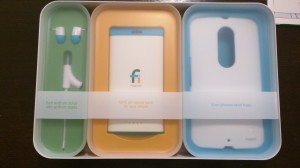I was scrolling through my twitter feed and saw someone tweet about receiving a Project Fi invite. While wondering “Is this a new wave of invites?”, my phone buzzed with a new email. An invite, which was not supposed to show up for another couple of months, was now here…
Project Fi is one of the coolest concepts that I’ve gotten to try from Google since…well…Project Glass. Fi is also something that I’ve been wondering/predicting that Google might do. See, my theory (which isn’t unique, mind you) is, Google would love to “own” the internet – from your device (phone, tablet, Chromebook, Computer) to the server (their data centers). Outside of the few customers on their Fiber service, there hasn’t been a way for them to own the cellular data side of the equation- till now. Fi uses WiFi and cell networks in tandem. The thought is no matter where you are, you should have access to either a cell signal or WiFi (maybe even both). So, how well does that theory hold up in the real world?
One of the nice things about Project Fi is it uses T-Mobile and Sprint service for the cellular side of things. Since living in the Cleveland, Ohio area offers great T-Mobile service and fantastic LTE speeds to boot, I was pretty optimistic about the service quality. I decided to take my current T-Mobile service off of my Nexus 6 (currently the only phone Project Fi supports) and take it for a spin.
The initial sign-up process happened online while redeeming my invite. There I chose my data plan and whether I wanted to get a Nexus 6 with the welcome pack or not (I didn’t). The welcome pack was one of the coolest boxes of swag I had gotten in recent memory. Inside the box was the SIM for Project FI, a Nexus 6 case, a portable battery pack, and a pair of headphones with a built-in splitter. While the headphones have a comically large jack/splitter section, they do have a nice look to them. The battery pack is a 6000 mAh pack with 1 and 2.1 amp output plus some nice Fi branding. The case is a hard case (soft touch back) with a shock absorbing liner. All in all, it’s a nice pack to get people jazzed about this experiment.

Once the Project Fi SIM card was in the phone, I quickly was sent a OS update (went from a T-Mobile Nexus 6 build to a Project Fi build). After that was installed, I set off to test out the service quality. As of this writing, I’ve tested speeds in various areas (and surrounding parts): Cleveland, Ohio/ Boca Raton, Florida/ Atlanta, Georgia (this coming weekend). The speed tests for Cleveland actually beat my dedicated T-Mobile service out in certain areas. In other areas, it was a bit slower than what I was getting with T-Mobile. My coworker Austin actually got it to connect to a trusted WiFi network in Boca Raton, Florida (speeds were so-so). Overall, it an interesting experience I plan to test more when I head out to San Francisco next month for Dreamforce!



Are you still using this service? I am in the same area and contemplating on this!
LikeLike
I have it “paused” currently as it’s not my daily driver (my daily driver is on T-Mobile though). If you don’t mind the lack of device selection and aren’t in a contract, it’s probably worthwhile.
Just remember, this is still an “experiment” to them 🙂
LikeLike